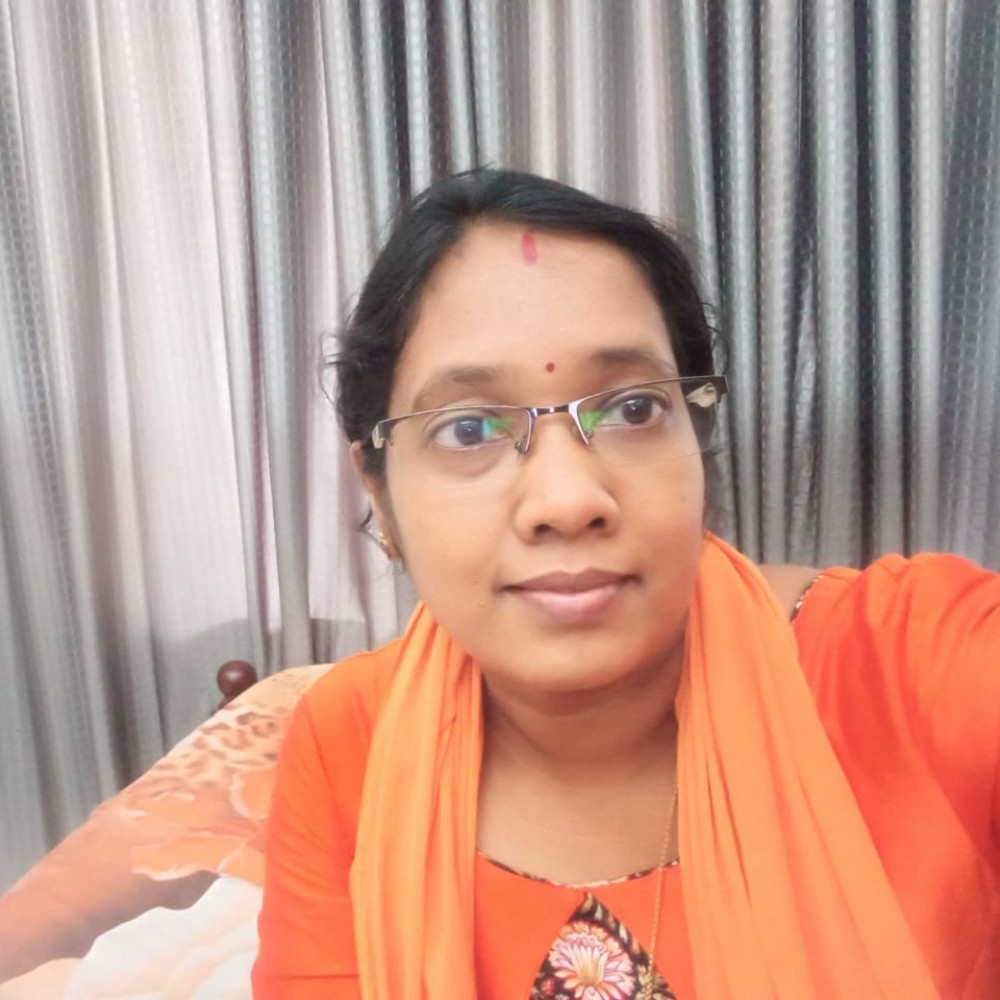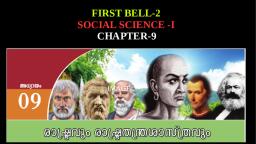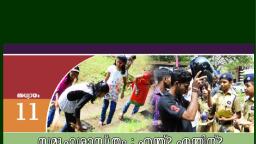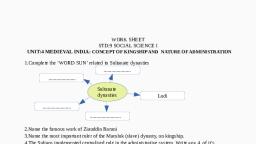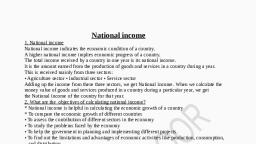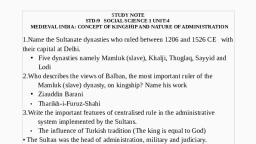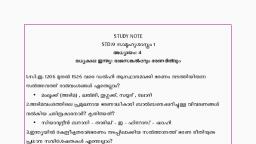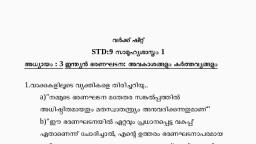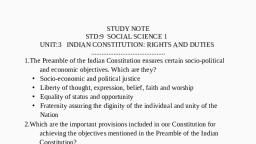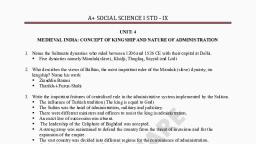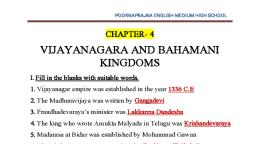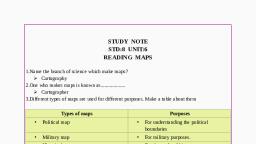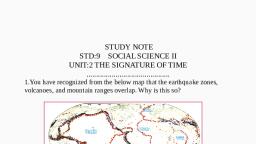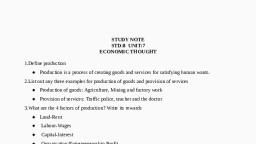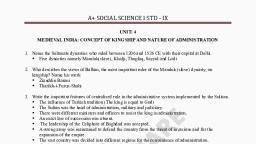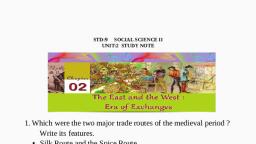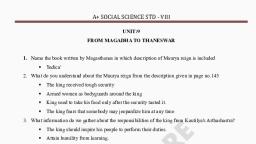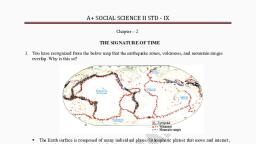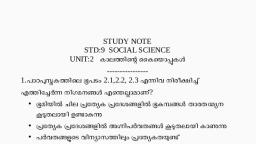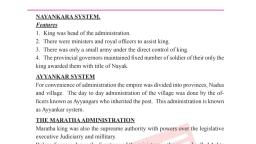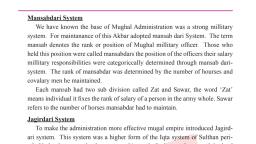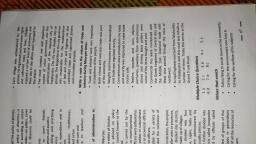Page 1 :
STUDY NOTE, STD:9 SOCIAL SCIENCE 1 UNIT:4, MEDIEVAL INDIA: CONCEPT OF KINGSHIP AND NATURE OF ADMINISTRATION, , 1.Name the Sultanate dynasties who ruled between 1206 and 1526 CE with, their capital at Delhi., • Five dynasties namely Mamluk (slave), Khalji, Thuglaq, Sayyid and, Lodi, 2.Who describes the views of Balban, the most important ruler of the, Mamluk (slave) dynasty, on kingship? Name his work, • Ziauddin Barani, • Tharikh-i-Furuz-Shahi, 3.Write the important features of centralised rule in the administrative, system implemented by the Sultans., • The influence of Turkish tradition (The king is equal to God), • The Sultan was the head of administration, military and judiciary., • There were different ministers and officers to assist the king in, administration., • An exact law of succession was absent., • The leadership of the Caliphate of Baghdad was accepted., • A strong army was maintained to defend the country from the threat of, invasions and for the expansion of the empire., • The vast country was divided into different regions for the convenience, of administration., • Regional laws prevailed at the village level, 4.Write short note about the administrative system at the local level during, the Sultanate period?, • The empire was divided into provinces, shiqs, parganas and villages., • Separate officers were appointed for each division., • Their authority was not hereditary., • The maintenance of law and order, judicial administration, collection, of taxes and organization of the army were the chief duties of these, officers., • They were under the direct control of the Sultan., • The Sultan did not directly intervene in the administration of the, villages., Prepared by Priya B; HST (SS) CSHSS Thrissur visit www.shenischool.in or whatsapp, 7012498606 Telegram https://t.me/Shenibloggroup
Page 2 :
5., •, , •, , •, •, •, •, •, •, 6., •, 7., •, •, •, , •, •, •, •, •, , •, •, , Iqta System was the one of the characteristic features of the Sultanate, period. Justify., The country was divided into different parts and these were entrusted, with the nobles who were also the military commanders. These, divisions were known as 'Iqtas', And their holders were known in different names as Iqtadar, Muqti, and Wali., The revenue collection and judicial administration of these divisions, were the main duties of these Iqtadars., They were also duty bound to maintain an army of their own., They used part of the revenue collected from the Iqta for their own, expense and the rest for conducting the administration., But they were not provided with independent authority., When the administration at the centre became strong, the, authority of the Iqtadars got restricted., The Iqtas later became the provinces., Who implemented reform with the intention of maintaining a large, army with less expenditure? Name the reform, Alauddin Khalji-Market Reforms, Examine the role of the market reforms in strengthening the military, power during the Sultanate period., The Sultans always paid attention to maintain a well equipped army, It was necessary to control the prices of essential commodities to, reduce the military expenditure., The government fixed the prices of essential commodities., Hence the merchants were forced to sell their products at the fixed, price., Black marketeers and hoarders were strictly punished., The weights and measures were unified., Established granaries to store the grains bought from the peasants, Distributed corns during the time of famines at a moderate price., Officers were appointed for the strict implementation of the market, regulations., As a result, the soldiers were able to purchase commodities at a, moderate price., Prepared by Priya B; HST (SS) CSHSS Thrissur visit www.shenischool.in or whatsapp, 7012498606 Telegram https://t.me/Shenibloggroup
Page 3 :
• Hence there was no need to pay them high salaries., • Through these acts, the Sultan curtailed the military expenditure and, the amount thus saved was utilized to enhance the strength of the army, 8.Which dynasty ruled Delhi after the Sultanate period?, • Mughal dynasty, 9.Who established Mughal Empire in 1526 CE?, • Babur, 10.Name the important sources of information on the administrative system, of the Mughal period written by Abul Fazl, • The Akbarnama, 11.Name the main rulers of Mughal dynasty, 1., 2., 3., , 4., , 5., , 6., , 12.Write the features of the Mughal administration., • Divine Right of Kingship, • The influence of Turkish and Mongol traditions., • Powers centralized in the king., • Based on military power., • Assistance of ministers and officials in the administration., • Existence of local administration, 13.The Mughals paid special attention to the local administration. Explain., • For the convenience of administration, the country was divided into, Subahs, Sarkars, Parganas and Villages, Prepared by Priya B; HST (SS) CSHSS Thrissur visit www.shenischool.in or whatsapp, 7012498606 Telegram https://t.me/Shenibloggroup
Page 4 :
• . There was a chain of officials for the administration of each division., • The collection of revenue, judicial administration and supervision of, the army were their responsibilities., 14. Akbar became successful as a ruler, acceptable to all through his, administrative measures. Substantiate., OR, What were the policies adopted by Akbar to win the support of all, • Adopted the title of Badsha-i-Hind (the Emperor of India), • To maintain religious harmony he formulated a new faith named Dini-Ilahi by inculcating the ideas of all religions., • The Rajputs such as Raja Todarmal, Birbal, Mansingh, etc. were, appointed as high officials., • Akbar and his relatives married Rajput ladies., • The army was strengthened by including different sections., 15.To what extent Din-i-Ilahi, formulated by Akbar was helpful in, maintaining administrative stability and religious harmony?, • Akbar wanted to maintain peace, friendship and unity among different, sections of people in his country., • In order to have intellectual discourses Akbar constructed the Ibadat, Khana at his capital, Fatehpur Sikri., • By inculcating the essence of all these discussions, he formulated the, ideology of Din-i-Ilahi., • It was a combination of ideas and principles of different Religious, discourses of Akbar with different religions., • He never compelled any one to accept it, • It did not have any rites, religious texts, places of worship or priests,, except the joining function., • Sulh-Kul or 'Peace to all' was its basic tenet, 16.Who introduced Mansabdari System?, • Akbar, 17.Mansabdari System was introduced to strengthen the authority of the, emperor. Substantiate., • The base of Mughal administration was a strong military system., • The emperors needed the support of the nobles and officials for the, maintenance and expansion of the empire, Prepared by Priya B; HST (SS) CSHSS Thrissur visit www.shenischool.in or whatsapp, 7012498606 Telegram https://t.me/Shenibloggroup
Page 5 :
• The term 'Mansab' denotes the rank or position of a Mughal military, officer., • Those who held this position were called Mansabdars., • The position of the officers, their salary and military responsibilities, were categorically determined through the Mansabdari system., • The rank of a Mansabdar was determined by the number of horses and, cavalrymen he maintained., • There were more than 30 ranks in the army of Akbar, Each Mansab had two sub-divisions called the 'Zat' and the 'Sawar'., • The word 'Zat' means individual. It fixes the rank and salary of a, person in the army., • Sawar refers to the number of horses a Mansabdar had to maintain., 18.Prepare a note on the common features of the Sultanate and the Mughal, administrations., • Divine Right of Kingship, • Powers centralized in the king, • The influence of Turkish tradition, • Assistance of ministers and officials in the administration., • Existence of local administration, 19.What are the similarities and dissimilarities between the Iqta system, of the Sultanate period and the Jagirdari system of the Mughal period?, Similarities:, • The Jagirdari system was a higher form of the Iqta system of the, Sultanate period, • As in the Iqta system, the Jagirdars never lived in or ruled over the, land they received, • Existence of military commanders, • Main duty-Revenue collection, • The officers were provided possession right of the land only, Dissimilarities:, 1) Country divisions were known as 'Iqtas' and their holders were, known Iqtadar, Muqti and Wali, • Granted land in lieu of salary to the Mansabdars known as 'Jagir'. Such, officers were known as Jagirdars, Prepared by Priya B; HST (SS) CSHSS Thrissur visit www.shenischool.in or whatsapp, 7012498606 Telegram https://t.me/Shenibloggroup
Page 6 :
2) Iqtadar were not provided with independent authority, • The position of Jagirdar was not hereditary, 20.Write the important feature of the Chola administration, • The country was ruled by a central government which included the, king as the sovereign authority., • Ministers as advisors and the officers., • They followed the patrilineal system of inheritance., • The Chola administration was regulated through Royal decrees., • The orders of the king were circulated to other officers by an, important officer known as 'Olainayakam', • A strong military system including the navy., 21.The village autonomy was the most important feature of the Chola, administration. Justify, • The Chola kings divided the country into Mandalams, Valanadus,, Nadus and Kottams, • A group of autonomous villages formed a Kottam., • All the responsibilities and authorities relating to the administration of, the villages were vested with the people of the villages., • Two councils known as the Ur and the Sabha functioned for the, purpose of village administration., • The people of the whole village was included in the Ur, whereas the, Sabha was only a Council of the Brahmins., 22.Write the features of the Sabha., • There were separate regulations for the functioning of the Sabha, • The Sabha was divided into many panchayats with separate, responsibilities for administrative convenience., • The members of the Panchayats were determined through both, selection and election, • The members were elected annually., • One person could serve as the member of the panchayat for a, maximum of three consecutive terms., • Those who were accused of crimes such as bribery and theft were not, given the chance to contest in the election., • The members of the Sabha were called Perumakkal, • The members of the panchayats were known as Variya perumakkal., Prepared by Priya B; HST (SS) CSHSS Thrissur visit www.shenischool.in or whatsapp, 7012498606 Telegram https://t.me/Shenibloggroup
Page 7 :
23.What were powers of Sabha?, • Receive land for the temples., • Collect tax by surveying land., • Undertake public works for the welfare of the people., • Keep accounts and records, • Conduct judicial administration of the village., 24.Who was the famous ruler of Vijayanagara Empire of South India?, Name his work., • Krishna Deva Raya, • Amuktamalyada, 25.Write short note on the administrative system of Vijayanagara Empire?, • Centralised administration, • The king had the support of a strong army., • To protect the country from the enemies, they constructed large forts., • The central administration of the Vijayanagara Empire was called, Nayankara system, • The local administration was the Ayyagar, 26.Write the features of Nayankara system, • The King was the head of the central administration, • Ministers and royal officers to assist the king, • A small army under the direct control of the king., • The provincial governors maintained fixed number of soldiers of their, own, • They provided the service of the army to the king whenever necessary, • As they were also military heads, the king awarded them with the title, of 'Nayak' along with a specific area of land, • This system that prevailed at the centre was known as the Nayankara, system, 27.Write the features of Ayyagar System, • For the convenience of administration, the empire was divided, into provinces, nadus and villages., • Village was the basic unit., • The day-to-day administration of the village was done by the officers, known as 'Ayyagars',who inherited the post., , Prepared by Priya B; HST (SS) CSHSS Thrissur visit www.shenischool.in or whatsapp, 7012498606 Telegram https://t.me/Shenibloggroup
Page 8 :
The position of Ayyagars in the village administration was equal to, that of the Nayaks in the central administration., 28.Write the features of the Maratha administration., • Maratha king was the supreme authority with powers over the, legislature, executive, judiciary and military., • Central administration had the support of an elaborate ministry, • The ministers were the mere advisors of the king., • Their office was not hereditary, • There was an espionage to observe various officers and state affairs., • Local administration was prevailed, 29.Write short note about Local Administration of the Marathas, • The Maratha kingdom was divided into many parts for the, convenience of administration., • These divisions were provinces, districts (pranthas), parganas and, villages., • The officers were directly appointed by the king., • The country was further divided into two: 'Swarajya' and 'Mogalai'., • The Swarajya was the territories of the Marathas, • The Mogalai was the regions annexed to the kingdom., • In addition to the land tax collected from the Maratha country, (Swarajya) two kinds of taxes, Chawth and Sardeshmukhi, were, collected from the annexed regions, 30.Which were the two kinds of taxes collected from the annexed regions of, the Marathas?, • Chawth and Sardeshmukhi, •, , 31.Make a ‘Wordsun’ related to Ashtapradhan, , Prepared by Priya B; HST (SS) CSHSS Thrissur visit www.shenischool.in or whatsapp, 7012498606 Telegram https://t.me/Shenibloggroup
